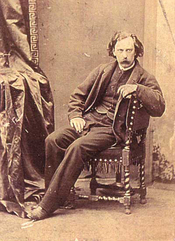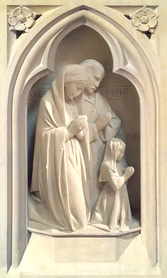Family Tree
|
 |
|
|
See John's FindAGrave info HERE
|
John Hardman Powell, 1827-1895
by Catriona Blaker John Hardman Powell, stained glass designer, deserves a study in his own right. As a very young man he came down to stay at The Grange, Ramsgate to assist Pugin with his many orders for stained glass, church plate, and other artefacts. He was the nephew of John Hardman Junior (1811-1867), Pugin’s great friend and respected colleague, with whom Pugin expanded the firm of Hardman’s in Birmingham for the making of stained glass and ecclesiastical metalwork. Through Pugin, the firm became very successful throughout the nineteenth century and set high standards of design and craftsmanship, initiated by Pugin and then developed by John Hardman Powell. Powell married Pugin’s first child, his daughter Anne, and became chief designer for Hardman’s after Pugin’s death in 1852. Under his direction the firm produced enormous amounts of stained glass for Anglican and Catholic churches throughout the country (and beyond) in the second half of the nineteenth century. Powell never forgot his debt to Pugin, from whom he had learnt everything, but gradually evolved a personal style, involving rather more elongated figures and a more exaggerated sense of movement than his master. He also wrote (1889) a vivid and affectionate memoir of his great teacher, Pugin in his Home. One of his best works, the large Immaculate Conception window, an elaborate and uplifting design, with a beautiful ethereal quality, pure colours, and a silvery overall light, is to be found in the north transept of Pugin’s St Chad’s Cathedral, Birmingham, and was designed in 1868 in memory of John Hardman Junior. Powell’s mother, Lucy, also assisted in the Pugin/Hardman business by making, and executing the embroidery for some of the elaborate and splendid church vestments designed by Pugin. John Hardman Powell also designed fine domestic and church metalware, and expounded his theories about design, which owe much to Pugin (and something also to Ruskin) in the interesting but hard to obtain Some Stray Notes on Art (1888) – lectures to students at the Birmingham School of Art. An obituary of J.H. Powell, in The Birmingham Weekly Post, comments: ‘Mr Powell’s modesty, aimiability and charm of manner were on a par with his artistic qualities’. |
Four publications in particular, will be of value to those who want to know more about Powell and the Hardmans. They are: Hardman of Birmingham: Goldsmith and Glasspainter, by Michael Fisher, 2008, Landmark Publishing, Ashbourne, Derbyshire, The Pugins and the Hardmans by Brian Doolan, 2004, an interesting account of the Hardman family and firm right up to present times, obtainable from St Chad’s Cathedral shop, Birmingham, and Pre-Raphaelite Birmingham by Roy Hartnell, 1996, Brewin Books, Studley, Warwickshire, which gives a useful introduction to the active and artistic cultural life of Birmingham in the nineteenth century. For the Hardman family specifically in their role as leading Birmingham Catholics and generous benefactors, Sister Barbara Jeffery’s Living for the Church before Everything Else is much to be recommended. This is available from the author at the Convent of Mercy, Parkers Row, Bermondsey, London SE1 2DQ.






